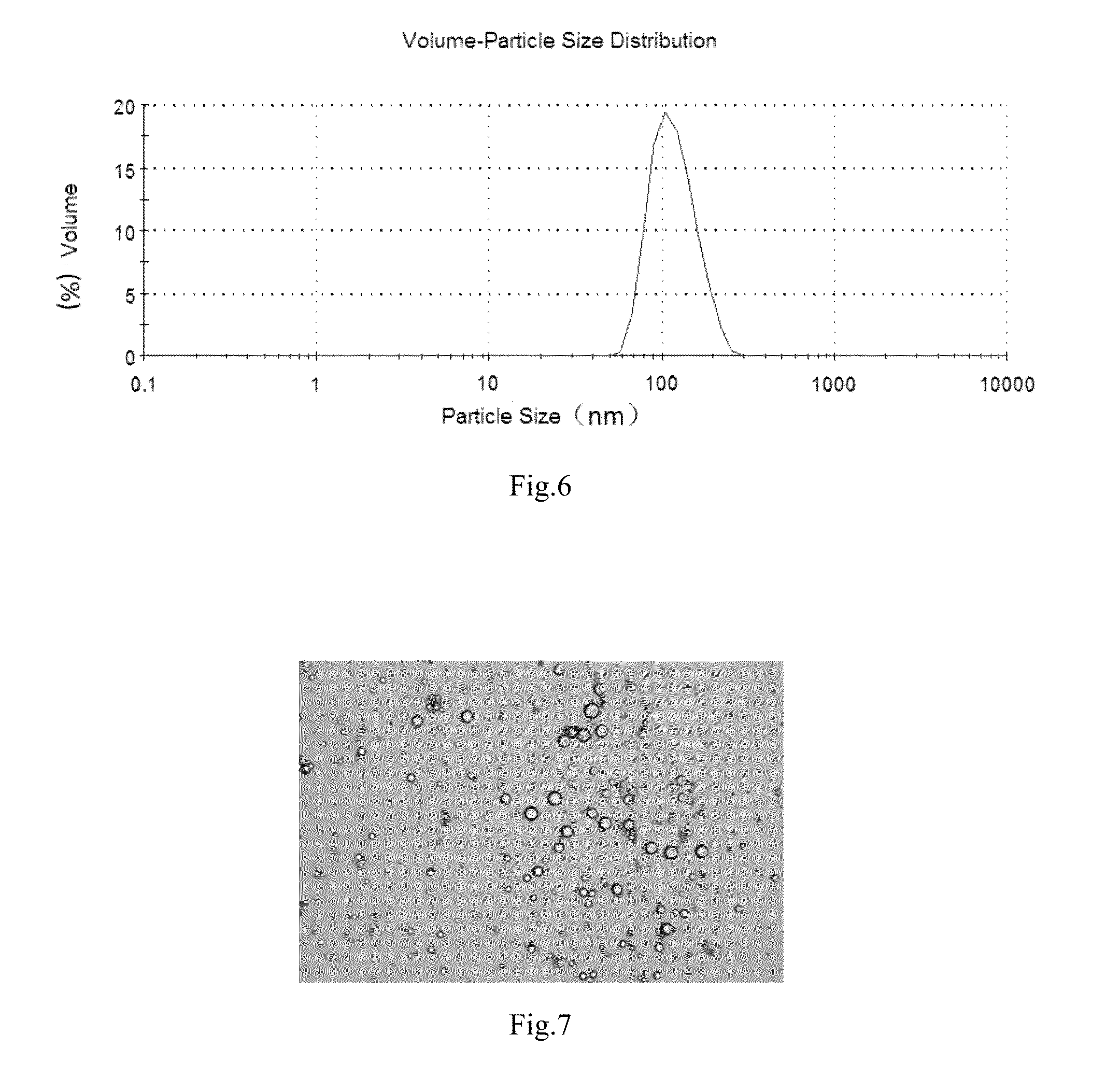An oil-in-water emulsion containing no surfactant and use thereof
a technology of oil-in-water emulsion and surfactant, which is applied in the field of biological products, can solve the problems of inability to induce cellular immunity and mucosal immune effects, aluminum adjuvants, and generally weak immunogenicity and immunoprotection of antigens, so as to avoid the adverse effect of surfactants, increase formulation biocompatibility, and effectively stimulate immune cells
- Summary
- Abstract
- Description
- Claims
- Application Information
AI Technical Summary
Benefits of technology
Problems solved by technology
Method used
Image
Examples
example 1
Preparation of the Oil-in-Water Emulsion by Using Poly-PLGA Particles
[0090]Preparation of PLGA Particles by Nanoprecipitation Method
[0091]Accurately weighing 0.30 g of PLGA (LA:GA being 50:50, the molecular weight being 110000 Daltons) with an electronic scale, dissolving them into 1 mL of acetone, dropwise adding such solution with No. 9 syringe needle at a rate of 1 drop per second into 20 mL of the aqueous solution (containing 1 wt. % of PVA (having an alcoholysis degree of 99% and a viscosity of 5.0 mPa·s), magnetic stirring with a stir speed of 500 rpm), stirring at 25° C. overnight, centrifugalizing the resulting solution for 20 min at 20000 g, discarding the supernatant, adding 5 mL of deionized water into the precipitate, dispersing by ultrasounding, centrifugalizing the solution for 5 min at 20000 g, discarding the supernatant, lyophilizing the precipitate to obtain the PLGA particles, placing the particles in the refrigerator at 4° C., wherein the resultant PLGA particles ...
example 2
Preparation of the Oil-in-Water Emulsion by Using Aluminum Hydroxide Particles
[0095]Preparation of Aluminum Hydroxide Particles by Microemulsion Method
[0096]Triton X-100, n-butanol and cyclohexane were mixed in a volume ratio of 1:0.5:20 and magnetically stirred (800 rpm, 5 min) to obtain the oil phase. The syringe propulsion pump was used to dropwise add 1 mol / L of AlCl3 solution (2 mL) to the oil phase (20 mL) under magnetically stirring (500 rpm) to obtain the reversed-phase microemulsion of aluminum chloride. Ammonia was dropwise added by the syringe propulsion pump to the aforesaid reversed-phase microemulsion at a rate of 0.5 mL / min to keep the reaction system to have a pH of higher than 10.0. After 2 h of the reaction, 10 mL of acetone was added to demulsify. The supernatant was removed after centrifugation (15000 g, 5 min). Absolute ethyl alcohol was used to repeatedly wash three times, and deionized water was used to wash once to finally obtain aluminum hydroxide particles ...
example 3
Preparation of the Oil-in-Water Emulsion by Using Calcium Phosphate Particles
[0099]Preparation of Hollow Calcium Phosphate Particles by the Template Method
[0100]3.0 g Tween 80, 0.25 g PEG 6000, 3.0 mL 0.5 mol / L of Tris-HCl (pH8.0) and 1.5 mL of deionized water were mixed and homogeneously stirred, ultrasounded for 20 min (10 W) to form non-ionic surfactant vesicae. 3.55 mL of CaCl2 (0.175 mol / L) solution was dropwise added and stirred for 0.5 h. Then 3.55 mL of Na2HPO4 (0.175 mol / L) solution was added to obtain a suspension of sodium phosphate particles which was then stabilized by adding 0.83 mL MgCl2 solution (0.075 mmol / L). After stirring for another 2 h, centrifugal washing, vacuum drying, hollow calcium phosphate particles were obtained. The particles had an average particle size of 210 nm, a shell thickness of 30-40 nm and a Span of 0.349. The prepared particles are hollow spheres.
[0101]Preparation of the Oil-in-Water Emulsion:
[0102]Accurately weighing 1.00 g of hollow calcium...
PUM
| Property | Measurement | Unit |
|---|---|---|
| particle size | aaaaa | aaaaa |
| particle size | aaaaa | aaaaa |
| molecular weight | aaaaa | aaaaa |
Abstract
Description
Claims
Application Information
 Login to View More
Login to View More - R&D
- Intellectual Property
- Life Sciences
- Materials
- Tech Scout
- Unparalleled Data Quality
- Higher Quality Content
- 60% Fewer Hallucinations
Browse by: Latest US Patents, China's latest patents, Technical Efficacy Thesaurus, Application Domain, Technology Topic, Popular Technical Reports.
© 2025 PatSnap. All rights reserved.Legal|Privacy policy|Modern Slavery Act Transparency Statement|Sitemap|About US| Contact US: help@patsnap.com



